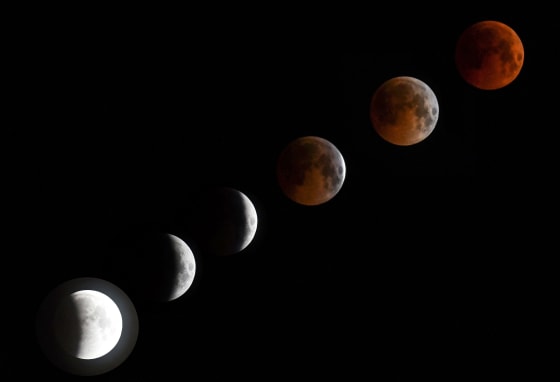Skywatchers across the continental U.S. will be treated to a total lunar eclipse overnight on Jan. 20-21, when Earth's shadow sweeps over the lunar surface to give it a reddish tinge and turn it into what some call a "blood moon."
This will be the first lunar eclipse of 2019 and the last total lunar eclipse until 2021. It coincides with the year's first full moon — a "wolf moon" in the folklore tradition because it occurs at a time of year when wolves howl outside villages — and comes when the moon is slightly bigger and brighter because it's at the closest point to Earth in its elliptical orbit.
Since it's a so-called supermoon that's being shadowed, some media outlets have dubbed this eclipse a "super blood wolf moon."
But if the eclipse will be outsized, your expectations probably shouldn't be.
"There is nothing 'wolfy' about this eclipse, and I've never really been able to tell a supermoon from a normal moon with my own eye," Tyler Nordgren, an astronomer in Ithaca, New York, told NBC News MACH in an email.
The eclipse will be visible across North and South America, as well as in parts of western Europe and Africa. Skywatchers in other parts of Africa, Europe and Asia will see a partial eclipse.
Things get started on Jan. 20 at about 10:30 p.m. Eastern Time, when Earth's shadow starts to cross the lunar surface. Totality — the point when the sun, moon and Earth are perfectly aligned and Earth's shadow covers the entire disk of the moon — occurs at 12:12 a.m. Eastern Time on Jan. 21.
"Everyone with a clear sky will have a spectacular view," Nordgren said, adding that he would be among those who venture outside for a look.
Don't worry about special eye protection. While solar eclipses must be viewed with special glasses or lenses, lunar eclipses can safely be viewed with the naked eye.
The eclipse is one of two lunar eclipses and three solar eclipses in 2019. There will be a partial lunar eclipse on July 16, but the next total lunar eclipse won't come until May 26, 2021.


